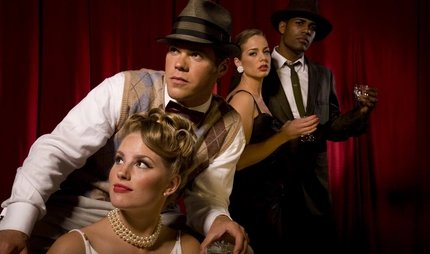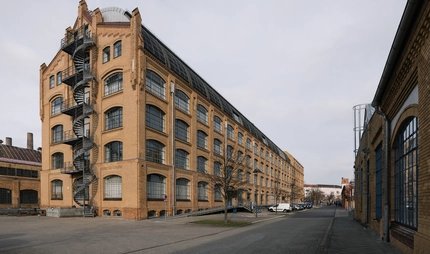
Women of the 1920s
When modernity was feminine
In the Berlin of the 1920s, women seized the opportunity for emancipation: they earned their own money, went to cafés without a man or went dancing with their girlfriends in the evenings.
The democratic Weimar Republic created freedoms that were previously unthinkable. Nowhere is this more true than in Berlin. In the Berlin of the 1920s, a fast, dynamic, even despicable freedom was created. The "new women" are among those who make the most determined use of this freedom. The atmosphere is anything but cheerful: Germany lost the First World War. Politics and the economy are dangerously unstable. Right-wing and left-wing extremists are trying to eliminate democracy by force, and the hyperinflation of 1923 is destroying the savings of large sections of the population. And yet art, culture and new ways of life are flourishing.
The "new woman"
The "new woman" can be easily recognized by everyone in the street scene. Instead of heavy dresses and corset as in the empire, she wears short dresses and a boy's head as feminine short hairstyle. Instead of emphasizing female curves, she lives a new ideal of beauty: androgynous and sporty.
In the evening and at night the "new women" show themselves in one of the 899 Berlin dance clubs. The short dresses are not only sexy but also practical. In them women can dance as they wish. And they don't necessarily need a male partner for that anymore. New styles like the Charleston can also be danced by women alone.
Her opponents hate and despise the "new women". They see in their appearance and behaviour a masculinisation of women and a decline of custom and tradition. Advocates of Berlin modernism, on the other hand, love the "new women" of the 1920s. For them she is an expression of emancipation and social progress. But why can so many women suddenly afford the new lifestyle and the latest fashion?
The woman of the 20s earns her own money
Mainly because more women are working than ever before. Every third Berlin woman is in work in her 20s. Most of them not out of a desire for economic independence, but out of pure necessity. Many men were killed in the First World War or can no longer work as invalids. And since inflation has destroyed assets, even in the middle class a marriage is often no longer enough to provide for them. Only the husband's salary is simply too little for a family these days. With their work, women contribute to the household of their husband or parents. In addition, some women finally have money for their own needs.
At the same time, more and more employers want to hire women, especially in the rapidly growing white-collar sector. Women advise as saleswomen in department stores, connect calls as telephonists or type at the typewriter as office workers. These jobs are easier, more prestigious and better paid than drudgery in factories or agriculture.
Women as stars of the Berlin modern age
In the beginning, the Berlin poet Mascha Kaléko is also an office employee. The clerk at the workers' welfare office of the Jewish organizations in Germany even sets a monument to her everyday work - with her "Chanson of Monday":
"Monday the world still has no face / And no one can look it in the eye. / Monday means: Getting up early again / Training for the weekly heavyweight / And the trains roar, the car yelps / Work marches in the cities / All streets echo with the factory and business / And the huge sums of money grow into an invisible notebook / But never into the notebook of the redneck."
At the end of the 1920s Kaléko became a celebrity with star character. During the day she often sits in the Romanesque Café at the Kaiser Wilhelm Memorial Church. Many artists and even more who would like to be artists cavort here.
The writer Vicki Baum also achieved her breakthrough in 1928, when the "Berliner Illustrierte Zeitung" published her book "Stud. Chem. Helene Willfüer" as a serial novel. Baum's heroine receives a doctorate in chemistry, raises her child as a single mother, invents a rejuvenating agent and finally marries her former professor.
Baum's heroine successfully breaks with the classic female role. A scandal for many, the National Socialists burn the books of the Jewish author, whose novel "Menschen im Hotel" even made Hollywood movies, publicly a few years later.

Living the scandal: Anita Berber
Not only in novels, but also in reality, women transcend traditional gender roles. More and more they do sports and do not limit themselves to gymnastics or tennis, which are considered decent in the empire. Trendsetters among the women of the Berlin Modernism of the 1920s are Vicki Baum or Marlene Dietrich, who keep fit with boxing training. The only scandal is the life of actress Anita Berber. She does everything that many contemporaries believe women should not do: She drinks cognac, takes drugs and fights. She is the first woman to wear a tuxedo and sets fashion standards. Otto Dix immortalizes her on canvas.
Berber dies in 1928 before her 30th birthday as a result of her years of drug addiction.
International Stars in Berlin
Berlin is a cultural hotspot that not only produces stars but also attracts them. Like the American revue dancer Josephine Baker, who is celebrating great success in Berlin
The Hollywood actress Louise Brooks, who with her black boyish head is still considered an icon of the time, is also shooting two films in Berlin.
Portraits of the time: the painter Jeann Mammen
The painter Jeanne Mammen, on the other hand, does not like to take centre stage. She wishes "to be only a pair of eyes, to go through the world unseen, to see only the others". Alone, she roams the big city in search of motifs, drawing designs in the dance halls and variety theatres. She often finds her motifs in the lesbian clubs of Berlin: she portrays muscular sportswomen, elegant girls in the latest hats or the androgynous garçonnes in shirt, jacket and top hat.
Mammen's world of expression is diverse, but she doesn't just celebrate the life of the modern woman in the 20s. In some of her works she also shows the loneliness and disillusionment of the people she observes. Most women cannot live on their salary alone.
The brief freedom and its quick end
The consequences of the world economic crisis and at the latest the seizure of power by the National Socialists put an end to the free world of the "new women". The National Socialists propagate a traditional image of women that forces women back to the stove. Outlawed and persecuted, many of the "new women" leave the country or are murdered by the National Socialists.
Only long after the end of National Socialism did a new phase of emancipation begin again.
Tips from visitBerlin
The 20's are more popular than ever and you can search for traces everywhere in Berlin. You can find a nice collection of original clothes from the 20s in the Museum of Decorative Arts. You can not only see but also buy art in the style of the 20s in the temporary bauhaus-archiv.
Don't miss a visit to the Deutsche Kinemathek - Museum für Film und Fernsehen. Here you will discover film clips and original props from the 1920s - and also clothes and devotional objects such as Marlene Dietrich's make-up case and cigarette case.
You will find the grave of honour of the Berlin Hollywood star at the cemetery Schöneberg III in Friedenau.
If you want to take a look at works by the "new women" yourself, go to the Berlinische Galerie. The gallery shows among other things the exact snapshots of Jeanne Mammen.



